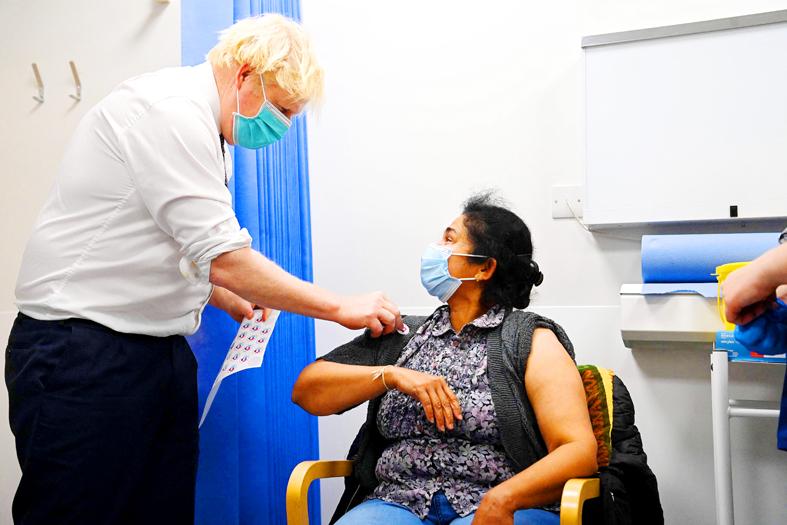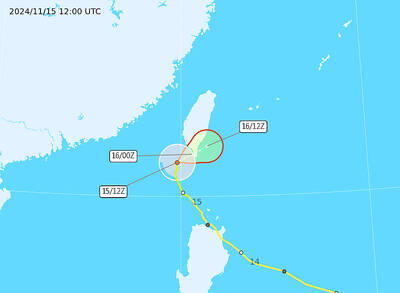Existing COVID-19 vaccines will struggle against the fast-spreading Omicron variant of SARS-CoV-2, the head of vaccine manufacturer Moderna said yesterday.
First reported to the WHO in southern Africa less than a week ago, the new strain has rapidly spread from Africa to the Pacific, and from Europe to North America as dozens of countries have announced travel restrictions.
While no deaths have yet been reported from Omicron, and it could take weeks to know how infectious and how resistant the strain might prove to vaccines, its emergence underscores how besieged the world remains by COVID-19, nearly two years after the first cases were recorded.

Photo: AFP
Moderna CEO Stephane Bancel told the Financial Times in an interview published yesterday that data would be available on the effectiveness of vaccines in two weeks’ time, but that scientists were pessimistic.
“All the scientists I’ve talked to ... are like: ‘This is not going to be good,’” Bancel said, warning against a “material drop” in the effectiveness of current jabs against Omicron.
Pfizer, another US drug maker, on Monday said that it began on Friday testing its current COVID-19 vaccine against the Omicron variant.
“I don’t think the result will be the vaccines don’t protect,” Pfizer CEO Albert Bourla said.
However, the testing could show that existing shots “protect less,” which would mean “that we need to create a new vaccine,” he said.
“Friday we made our first DNA template, which is the first possible inflection of the development process of a new vaccine,” he said.
Johnson & Johnson (J&J) also said on Monday that it is “pursuing an Omicron-specific variant vaccine and will progress it as needed.”
China warned that the fast-spreading Omicron variant would cause challenges in hosting February’s Winter Olympics in Beijing, with thousands of athletes, media and participants arriving from overseas required to enter a strict “closed-loop” bubble.
“But China has a lot of experience in responding to COVID-19,” Chinese Ministry of Foreign Affairs spokesman Zhao Lijian (趙立堅) said. “I firmly believe the Winter Olympics will be conducted smoothly.”
On Monday, US President Joe Biden said the strain was “a cause for concern, not a cause for panic,” adding that he does not foresee new lockdowns or extending travel restrictions for now.
Meanwhile, the US Centers for Disease Control and Prevention on Monday broadened its recommendation for COVID-19 booster shots for all adults as the new Omicron variant is identified in more countries.
The agency had previously approved boosters for all adults, but only recommended them for those 50 years and older or if they live in a long-term care setting.
“Everyone ages 18 and older should get a booster shot either when they are 6 months after their initial Pfizer or Moderna series or 2 months after their initial J&J vaccine,” CDC Director Rochelle Walensky said in a statement.

Tropical Storm Usagi strengthened to a typhoon yesterday morning and remains on track to brush past southeastern Taiwan from tomorrow to Sunday, the Central Weather Administration (CWA) said yesterday. As of 2pm yesterday, the storm was approximately 950km east-southeast of Oluanpi (鵝鑾鼻), Taiwan proper’s southernmost point, the CWA said. It is expected to enter the Bashi Channel and then turn north, moving into waters southeast of Taiwan, it said. The agency said it could issue a sea warning in the early hours of today and a land warning in the afternoon. As of 2pm yesterday, the storm was moving at

UPDATED FORECAST: The warning covered areas of Pingtung County and Hengchun Peninsula, while a sea warning covering the southern Taiwan Strait was amended The Central Weather Administration (CWA) at 5:30pm yesterday issued a land warning for Typhoon Usagi as the storm approached Taiwan from the south after passing over the Philippines. As of 5pm, Usagi was 420km south-southeast of Oluanpi (鵝鑾鼻), Taiwan proper’s southernmost tip, with an average radius of 150km, the CWA said. The land warning covered areas of Pingtung County and the Hengchun Peninsula (恆春), and came with an amended sea warning, updating a warning issued yesterday morning to cover the southern part of the Taiwan Strait. No local governments had announced any class or office closures as of press time last night. The typhoon

At least 35 people were killed and dozens more injured when a man plowed his car into pedestrians exercising around a sports center in the southern Chinese city of Zhuhai on Monday night. Footage showing bodies lying on the pavement appeared on social media in the hours after the crash, but had vanished by early Tuesday morning, and local police reported only “injuries.” It took officials nearly 24 hours to reveal that dozens had died — in one of the country’s deadliest incidents in years. China heavily monitors social media platforms, where it is common for words and topics deemed

Typhoon Usagi yesterday had weakened into a tropical storm, but a land warning issued by the Central Weather Administration (CWA) was still in effect in four areas in southern Taiwan. As of 5pm yesterday, Tropical Storm Usagi was over waters 120km south-southwest of Oluanpi (鵝鑾鼻), the southernmost tip of Taiwan proper, and was moving north at 9kph, CWA data showed. The storm was expected to veer northeast later yesterday. It had maximum sustained winds of 101kph, with gusts of up to 126kph, the data showed. The CWA urged residents of Kaohsiung, Pingtung County, Taitung County and the Hengchun Peninsula (恆春) to remain alert to